Climate Change in Europe
Climate Change - Climate Change in Europe
Climate Change – onset of winter in the year 2010 (2010-12-02)
Climate change is the term one uses for alterations in climate, which can lead to a sustainable structural change on the earth’s surface, provided that this accompanies a massive climatic alteration in the affected regions. Climate change is, from our perspective, initiated primarily by the intensity of solar radiation, which have repercussions for the earth’s magnetic poles. Depending on the repercussions for the poles, both the ocean currents and the earth’s surface (continents) change, which in turn have a renewed impact upon the ocean currents and consequently upon movements in the atmosphere, hence leading to an on-going change in climatic relationships. The process of global climatic change, from warm to cold periods and from cold to warm periods, lasts anywhere from 100,000 to 250,000 years and has occurred heretofore in varying intensities and at different levels.
The following International Research Institute for Climate and Society (IRI) ICE CORE DIAGRAM illustrates the official scientific findings obtained, through ice-core samples, regarding temperatures for the last 160,000 years.

ICE CORE VOSTOK temperature difference from present |
Quelle: http://iridl.ldeo.columbia.edu/SOURCES/.ICE/.CORE/.VOSTOK/.temp/
The change from warm to cold periods on the planet Earth is a planetary unique feature, which from our perspective is significantly responsible for the evolution of the human species. This is due to the fact that, if there were no climate changes, the human race as a whole would not be able to advance. This change from warm to cold periods is caused by changes in the angle of the earth’s axis relative to the sun, which warms the earth with its radiation. Because the earth’s axis is inclined at an angle of 23.44° (axial tilt or obliquity) relative to the sun, the seasons appear, which, combined with the earth’s magnetism, to lead an on-going change in climate for the earth.
This change in climatic conditions, which is called “climate change”, has accordingly been taking place since the earth’s origin; it impacts, sometimes more and sometimes less, all of the earth’s life forms, whether they are animals, plants or humans. Climate change can have various causes, but the repercussions heretofore have always been the same: In the earth’s northern hemisphere an ice age develops, conversely in the southern hemisphere the temperatures increase respectively.
As regards to our civilisation in central, east and west Europe, climate change during the previous 200,000 years is relevant. Out of the preceding 200,000 years Europe, due to enduring ice ages, was inhabitable for only about 20,000 years, which corresponds to a time span of approximately 10%. And out of these 20,000 years in which Europe has been inhabitable, humans have colonised the area for approximately 3,000 years; out of this 3,000 year time span there has existed in Europe a human civilization for only about 1,000 years.
If one assumes that an average human life span is approximately 60 years long, only 16.7 generations of humans have colonized Europe since the origin of the earth. These roughly 17 human generations have destroyed about 70% of the erstwhile forest stand in Europe for their own needs in less than 3,000 years, converting this into gases such as carbon dioxide and carbon monoxide.
The fact that this conversion of the erstwhile forest stand to heat and gases can have consequences for the ecological balance of Planet Earth, is something that we will most likely experience within this century. According to the Killikus Climate Model, we will experience a cold age i.e. cold phase in climatic conditions within the next 30 to 45 years. Precisely how extreme this “cold age” will be and how long it will last in Europe is not known. However, we have calculated that even under current conditions a cooling-off phase is arithmetically possible, which could have long-term repercussions for the European landscape.
Under the influence of an ice age in Europe, winter snowfalls would first of all appear at the beginning of June and mid-August. Moreover, the proper winter season would begin around the end of October and last until the next summer. Such a climatic change in north and east Europe would lead to migrations, similar to the migration which took place from 140 AD to 450 AD, which resulted in economic growth for north and central Africa. During this period, the forest stand in Europe would rejuvenate itself within a few decades, since European agricultural practices would only be possible between June and August. In the lower regions of Europe in the months between June and August, a thaw will set in and a swampy landscape will appear, similar to the Russian tundra, on today’s surfaces normally used for agriculture; this would make agricultural cultivation of the respective fields impossible. Agriculture will only be possible at higher altitudes during a cold-age climate change in Europe; this will lead in turn to a technical revolution.
Climate change is, in our opinion, a component of the Darwinian Evolution process, hence rendering it a part of the natural development of the planet Earth. Our contemporary knowledge regarding the approaching climate change has recently provided us with significant scientific, ethical and technological advances.
Climate Change in Europe
Climate change in Europe began as early as 20,000 years ago. About 17,000 years ago a considerable heating of the earth’s surface began in north and central Europe, which rendered Europe inhabitable for humans around 3,000 BC. According to the latest scientific findings, the current route of the Gulf Stream is supposed to have begun 15,000 years ago, contributing to the warming of north and central Europe. This warming process of the earth’s surface between 17,000 BC and 1,000 BC in north Europe was so extreme that the consequences of the previous Weichsel Ice Age disappeared without a trace, enabling colonisation of Europe since approximately 1,000 BC. In this manner, it was possible for the Romans to settle as far north as north England, bringing their southern civilisation to north Europe. If one assumes that the highly developed Romans had previously made their way as far north as England, then the question arises as to why a migration to the south began only a century later.
It was not until 600 AD that a renewed settlement of Europe began, which has enabled to this day considerable population growth. With small interruptions such as the “mini-ice-age” in the 15th and 16th centuries, Europe has been spared any significant cold periods, which does not imply, however, that a new cold period could not appear.
Climate Models
There are numerous computer-assisted scientific models for how this climate change could manifest itself in Europe in coming years. With the advent of the Killikus Simulation, it has become possible to simulate various prognoses:
Simulation of Maximum Temperature Increases in Europe
According to current prognoses, “Deadly heat waves, sinking coastal cities, droughts, famine – the consequences of global warming threaten to become catastrophic” (Source: ↑Klimawandel Spiegel Online)
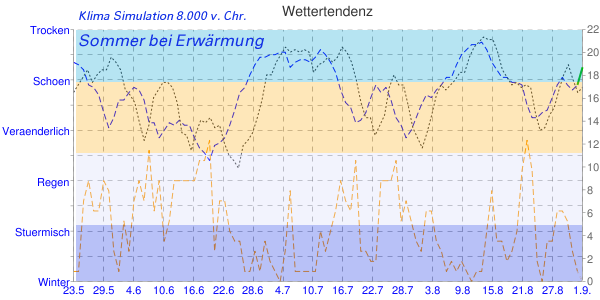
According to the Killikus Simulation of the all-time highest temperatures in Europe according to data from the International Research Institute for Climate and Society for the last 17,000 years, extremes were found of a very warm to hot summer and a short winter in December lasting only a few days. Storms and high-wind thunderstorms cannot, under these conditions involving simulation of an ongoing increase in temperatures in Europe, be proven.
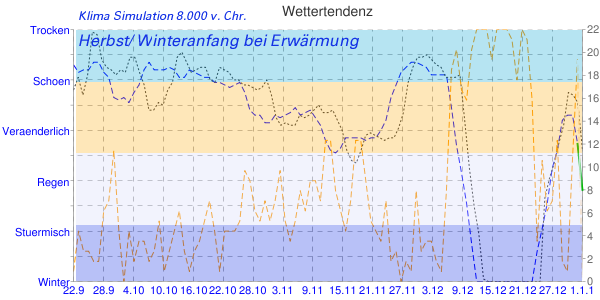
Illustration 1.1 and Illustration 1.2 show a representation of climatic circumstances with an increase in temperature similar to that of the times of the Romans in north Europe, approximately 45 BC. The simulation illustrates that precipitation in summer and autumn is not possible. The beginning of winter in December remains unaffected, even with a temperature maximum from climate change.
Climate Change of the Present
In the present age, we will experience continuously changing weather, with consequences for the climate, which tends to lead more likely to increased precipitation rather than higher temperatures. Considerably high summer temperatures will appear, with a high probability, only between the 16th of June and the 16th of July, as well as between the 9th and 15th of August.
The overall climatic conditions however are trending towards humid and rainy, partially stormy weather, since it can be seen in the model in the summer months that cold snaps (4.6. /16.6. / 16.7. / 28.7. and 21.8.) will appear, which would normally be attributable to the autumn months.
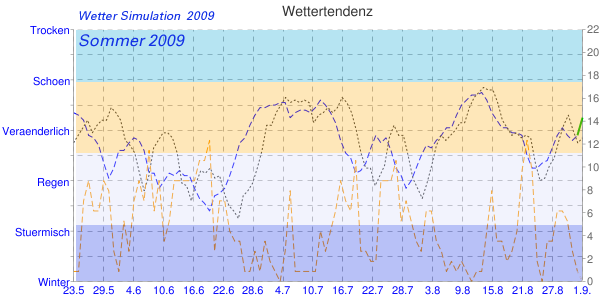
Autumn-like weather and temperatures around the 0°C freezing point will be expected, during this current phase, around the 28th of September, and winter-like weather can appear, under these current conditions, as early as the 28th of October or 15th of November. This depends of course on what is meant by winter-like weather.
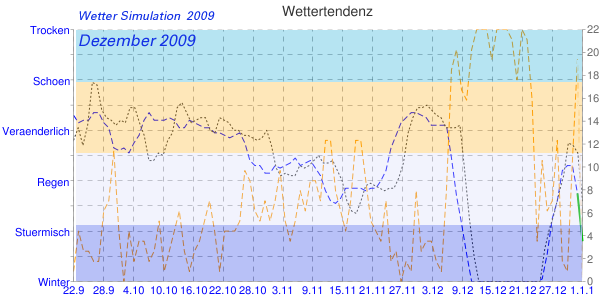
Current climatic conditions in the Killikus Modell tend more to reflect a move to a cold age rather than a tendency towards a warming period, which is still not inconsistent with the general warming trend for the climate. According to the Killikus Climate Theory, a sustainable warming of the climate is the physical condition for a climate change to a cold age.
Simulation of a Maximum Decrease in Temperatures in Europe
We are not aware of a significant climate simulation regarding a maximum decrease in temperatures. Our simulation of an ongoing warming of the climate on the earth shows as a consequence of the warming of the climate, a cold age with the following characteristics:
The weather during a cold age in Europe is characterised, almost the whole year, by rain, snowfall and stormy climatic conditions. Even the summer peak can produce in Europe, depending on the weather situation, snowfall, accompanied by stormy winds. In winter as well, constantly changing precipitations of all kinds are possible. The temperatures in the summer can be compared to the current winter temperatures in Greenland, and the winter temperatures can be compared to the current temperatures in Siberia.
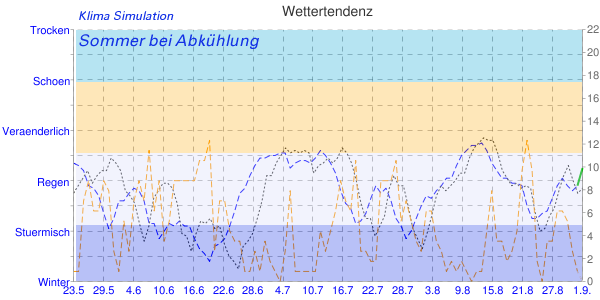
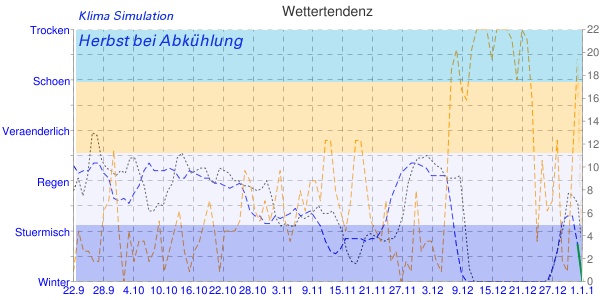
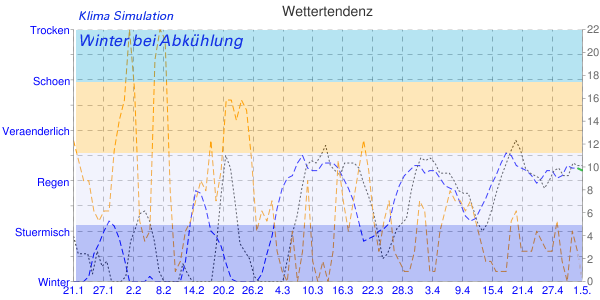
Causes for Climate Change
The reason for this constantly reoccurring climate change, the change between warm and cold periods on the earth, is the inclination of the earth’s axis, which is responsible for the seasons as well as the earth’s fluid and evaporated water resources.
The only constant in the earth’s climate is the annual “winter” of the northern hemisphere. This constant winter is, ultimately, responsible for the change from warm periods to cold periods or cold ages to warm ages.
Explanation
The earth’s water supplies transport the available energy from the earth’s surface in the form of heat from point A to point B and from point B back to point A. Water appears on the earth in a solid form, as icebergs or in a fluid form, as oceans. If a section of the earth’s water assumes the form of ice, the earth’s surface and the atmosphere heat up until water in an evaporated form is once again available. This is the manner in which the pathways and directions of energy transport are in constant flux on the earth.
If the available energy of the earth is transported to the north, a long-term cold age will appear due to the constant reoccurring “winter”, and this will continue until no more energy can be transported to the north, which in turn leads to a warm age.
Conclusion
- If the earth’s water assumes a solid form, the probability for considerable precipitation becomes increasingly lower, which leads to increasing temperatures.
- • If the earth’s water assumes only a fluid form, the probability for considerable precipitation increases; this has repetitively generated cold ages (i.e. ice ages), caused by the constantly recurring “winter”, over the last 200,000 years.


